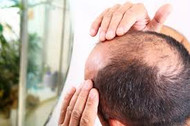From Strands to Strength: Understanding & Tackling Hair Loss
Posted by Xandrox on 22nd Apr 2025
Hair loss can be a frustrating and emotional experience. Whether you're noticing a few extra hairs in the shower drain or significant thinning over time, it's natural to wonder: Why is this happening - and how can I stop it? In this post, we’ll dive into the common causes of hair loss, the difference between thinning and balding, and effective ways to regain control of your hair health. So please continue reading to learn more.
What Causes Your Hair to Fall Out?
Hair loss can stem from a variety of reasons, both temporary and permanent. Some of the most common causes include:
-
Genetics – Hereditary hair loss, also known as androgenetic alopecia, is the most common cause of baldness.
-
Hormonal changes – Pregnancy, menopause, thyroid imbalances, and conditions like polycystic ovary syndrome (PCOS) can disrupt hair growth.
-
Medical conditions – Autoimmune diseases like alopecia areata, scalp infections, or chronic illnesses may trigger hair loss.
-
Medications – Drugs for cancer, arthritis, depression, heart problems, and high blood pressure can have side effects that include hair loss.
-
Nutritional deficiencies – Lack of iron, protein, or essential vitamins like biotin or vitamin D can weaken hair.
-
Stress and trauma – Emotional or physical stress, surgery, or sudden weight loss may lead to temporary hair shedding (telogen effluvium).
How to Stop Hair Loss
Stopping or slowing hair loss often requires a combination of lifestyle changes, medical intervention, and patience. Here’s what you can do:
-
Consult a dermatologist or trichologist – They can help diagnose the root cause and recommend targeted treatments.
-
Use clinically-proven treatments – Options like minoxidil, or platelet-rich plasma (PRP) therapy can be effective.
-
Maintain a balanced diet – Prioritize protein, iron, zinc, and vitamins A, D, and B-complex.
-
Be gentle with your hair – Avoid tight hairstyles, excessive heat styling, and harsh chemical treatments.
-
Manage stress – Practices like meditation, yoga, or regular exercise can help regulate stress hormones that affect your hair.
Understanding Thinning vs. Balding Hair
-
Thinning Hair: This is usually gradual and may involve increased hair shedding or reduced volume over time. It can affect the entire scalp or certain areas (like the crown or hairline).
-
Balding Hair: Often refers to more advanced hair loss, including noticeable patches or receding areas. Balding tends to be more common in men due to genetics and hormonal factors.
The earlier you catch it, the more options you’ll have for treatment.
In Summary
Hair loss can be complex—but it’s not the end of the road. Understanding the cause is the first step toward taking action. Whether it’s adjusting your lifestyle, nourishing your body, or exploring medical treatments, you have the power to support healthy hair growth.

